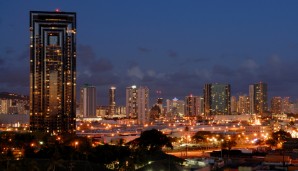
The challenge
The challenge in 2005 — a luxury high-rise proposed in Kakaako Makai, a 600 acre-area situated on Honolulu’s waterfront between Waikiki and downtown — provoked a strong community reaction. The area is under the jurisdiction of the Hawaii Community Development Authority (HCDA). It includes public and private land and a variety of existing uses including open space, office buildings, car dealerships and the University of Hawaii medical school. Project opponents had different interests, but they were united in their opposition to what they regarded as a lack of public consultation regarding both the project and the future of the entire Kakaako Makai area.
Opponents formed the Save Our Kakaako Coalition and spent months organizing, lobbying HCDA and the Legislature, and trying to create a “People’s Plan” for the area. They persuaded the Legislature to pass a resolution requiring HCDA to engage all stakeholders in a collaborative process to develop a shared vision and set of guiding principles that would provide a framework for HCDA’s development plan for Kakaako Makai.
HCDA designed a two-phase process. The first phase was a community outreach program to identify and convene individuals with a stake in Kakaako Makai who would comprise an Advisory Working Group (AWG) to advise HCDA. The second phase was intended to be a collaborative process of AWG members to produce a vision for Kakaako Makai and guiding principles that would shape a more detailed development plan. Many of the people in the original Save Our Kakaako Coalition as well as others interested in the future of the area joined the AWG.
The process
For the first phase, HCDA retained a local planning firm to meet with members of the original coalition and other interested groups and individuals. The planning firm’s report, based on 47 interviews, reported some shared views among interviewees as well areas of contention regarding what uses should be paramount in Kakaako, including, in particular, how much green space should be protected and whether residential housing should be allowed. The report also noted some hostility toward HCDA regarding their style of dealing with the public, their perceived unwillingness to work with community groups and the perceived lack of transparency.
After reviewing the consultant’s report, HCDA convened the first public meeting for the AWG. All those who had participated in the interviews or expressed an interest in the process were invited. HCDA encouraged the AWG to organize itself in a way that was “open, transparent and inclusive” to produce a vision and guiding principles. In turning the collaborative process over to AWG, HCDA also authorized them to find and contract with facilitators to assist in developing a vision and set of guiding principles. Several months were spent in organizational meetings and in procuring funds to hire facilitators and identify and interview potential candidates. In September, staff members from the Program on Conflict Resolution at UH were chosen to assist with Phase 2 of the process.
Much of the fall, 2007 was taken up with organizational issues and educational activities. The AWG renamed itself the Community Planning Advisory Group (CPAC), and chose leaders and a steering committee to plan the group’s monthly meetings. Tensions between members of the original Save Kakaako Coalition and the new members of the CPAC continued to play out in the choice of the steering committees, meeting agendas and group governance issues, including how decisions would be made about the eventual guiding principles yet to be developed. About half of the group’s monthly two-hour meetings were used to educate the group on the history of the area, current and proposed uses, legal issues and coastal hazards. Eleven presentations were made, including those by the UH Vice Chancellor for Research who defended the need for a bio-hazard facility in the area; the Office of Hawaiian Affairs; Kewalo Keiki Fishing Conservancy; and HCDA itself. Most of the educational sessions were routine information sharing, but when presenters asserted the value of particular land use priorities for the area including park space, housing or a performing arts center, this provoked some resistance.
After several months of education and organization, the group began the processes of identifying a vision as well as guiding principles for the area. After spending some time reviewing ‘typical’ vision statements, meeting participants (about 50 usually attended) were invited to individually identify the words or phrases they thought should be part of a vision statement. These words and phrases were collected and recorded on newsprint and handouts; between meetings they were sorted and grouped using computer search software. At a subsequent meeting, the large group was invited to break into smaller groups to work on combining statements into a single vision. These small groups produced several vision statements that were posted for the group to review. It soon became clear that while most of the group preferred a short vision statement that could be easily memorized, a few wanted a much more comprehensive and detailed vision. After several failed efforts to help the group combine statements or portions of statements, the facilitators suggested that rather than force a resolution, the vision statements would be put aside in favor of work on the guiding principles. The facilitators’ process assumption was that some of the detail and specificity sought by several in the group could be better expressed in guiding principles.
The process of developing guiding principles was similar to that of developing the vision statement. Individuals wrote up ideas for guiding principles. They then worked with others in small groups to revise and combine their principles. Small group lists of guiding principles were compiled and recorded on large sheets and handouts for the group to review. The group began with more than 240 candidate principles. After reviewing the principles, the group agreed that a more efficient process would be to identify the content areas (such as open space, public access and cultural values), that the guiding principles should reflect and then work together to refine the language. After two meetings, the group had a workable list of about 20 principles, but much work remained to craft language acceptable to the group.
The process of working on a vision and guiding principles heightened tensions in the group. Members had expressed support for consensus and it had long been clear—and agreed to—that consensus did not mean unanimity. The group aspired to the highest possible degree of agreement, but adopted a super-majority voting rule in instances where clear consensus was lacking. Fearing that some special interest group might seek to dominate the decision on a vision or specific principles by turning out large numbers of participants for a meeting in which a vote was likely, the group had earlier agreed that voting was limited to those who had participated in a substantial proportion of recent meetings.
As the group discovered, developing the vision and guiding principles was less about voting specific principles in or out, and more about the careful selection of words and phrases that captured the intent of the group and the spirit of the task. This sort of editing is often delegated to a consultant or a writing sub-committee, but some in the group were reluctant to give up control of this process. The Steering Committee, which was generally representative of the group as a whole, eventually took over the editing process and completed the task after several months.
HCDA turned CPAC’s vision and guiding principles over to a mainland design firm with whom they had contracted to produce a conceptual plan. Upon the completion of the conceptual plan in 2010, HCDA convened public meetings to present the plan. Many CPAC members opposed the plan, claiming it violated the vision and guiding principles. A revised plan was unveiled in the fall of 2010.
Observations/Lessons
- Some collaborative processes become extensions of previous substantive and relationship conflicts. The Save Kakaako Coalition struggled with legislators, HCDA officials and other community groups and corporations in their opposition to the construction of luxury condos in Kakaako Makai and their desire to create a more open, inclusive planning process. Some of the substantive issues, stereotyping, attributions of motive, distrust and personal tensions that characterized that legislative phase carried into the collaborative design process.
- Lack of trust between participants in a collaborative process can undermine the effectiveness of the process. Participants in this process were self-invited. Some had been engaged with the issues for years, while others had been involved for a matter of weeks or months and were unknown to longer-term advocates. Distrust among the some of the participants, of the HCDA and of the facilitators, meant that each step of the process had to be carefully reviewed and the implications had to be thoroughly scrutinized by the whole group and specific individuals. Such transparency created increased clarity about intended outcomes of each process step, but it slowed the process and tended to stifle creativity.
- Commitment to particular process outcomes can undermine creative problem solving. Some of the long-term advocates for better planning in Kakaako Makai developed clear images of ‘best’ uses for the area during the course of their involvement. Others who entered the process did so because they were advocates for particular land uses or activities in the area. These idealized visions for Kakaako Makai sometimes clashed, making it difficult to agree on language for guiding principles that might accommodate conflicting images of ideal uses.
- Dedicated participants can salvage even a long, difficult process. A substantial number of participants came week after week to plenary sessions, steering committee meetings and public hearings. Many remained energized and interested even while immersed in the details of choosing the right verb or adjective in drafting guiding principles. Their commitment resulted in a product that is guiding the planning for Kakaako Makai.
Related links
